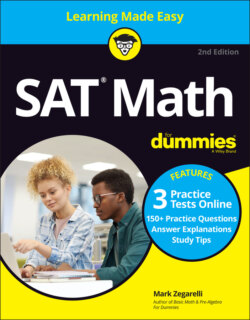Читать книгу SAT Math For Dummies with Online Practice - Mark Zegarelli - Страница 80
Getting familiar with a few advanced calculator moves
ОглавлениеIf you've got your sights set on breaking 700 on the SAT, you should invest in a graphing calculator and spend some time figuring out how to use its more advanced features. Here are a few skills such that are likely to come in handy:
Fractions: Some calculators allow you to convert decimals to fractions, perform operations on fractions, and specify that the answer be provided as a fraction. These features can be useful when a multiple-choice question provides fractional answers.
Parentheses: Knowing how to group numbers using parentheses allows you to tell the calculator which operations to do first.
Higher-order roots (radicals): Some calculators have a key that allows you to find higher-order radicals such as cube roots, fourth roots, and so on. But many other calculators require you to calculate higher-order roots as powers of fractions, placing the fraction in parentheses. Find out how to do this and practice it a few times so you can repeat it on the test if needed.
Solving equations: The equations that you need to solve on the SAT aren't designed to be too complex, but if your calculator allows you to solve an equation for a variable, you may find this feature useful.
Graphing functions: In some cases, you may find graphing a function helpful for answering a question. For example, graphing may save time solving a quadratic equation: Just graph the function and zoom in on the zeros to find x.
Using input-output tables: Graphing calculators usually have a feature allowing you to make an input-output table for a function. This feature may come in handy on the SAT, so check it out.
